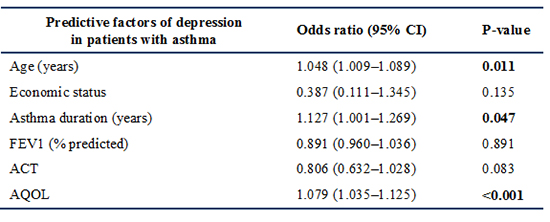1. Bateman ED, Hurd SS, Barnes PJ, Bousquet J, Drazen JM, FitzGerald M, Gibson P, Ohta K, O'Byrne P, Pedersen SE, et al. Global strategy for asthma management and prevention: GINA executive summary. Eur Respir J. 2008; 31:143–178.
2. Holgate ST. Mechanisms of asthma and implications for its prevention and treatment: a personal journey. Allergy Asthma Immunol Res. 2013; 5:343–347.
3. Andrade L, Caraveo-Anduaga JJ, Berglund P, Bijl RV, De Graaf R, Vollebergh W, Dragomirecka E, Kohn R, Keller M, Kessler RC, et al. The epidemiology of major depressive episodes: results from the International Consortium of Psychiatric Epidemiology (ICPE) Surveys. Int J Methods Psychiatr Res. 2003; 12:3–21.
4. Goodwin RD, Jacobi F, Thefeld W. Mental disorders and asthma in the community. Arch Gen Psychiatry. 2003; 60:1125–1130.
5. Lu Y, Mak KK, Van Bever HP, Ng TP, Mak A, Ho RC. Prevalence of anxiety and depressive symptoms in adolescents with asthma: a meta-analysis and meta-regression. Pediatr Allergy Immunol. 2012; 23:707–715.
6. Wong KO, Hunter Rowe B, Douwes J, Senthilselvan A. Asthma and wheezing are associated with depression and anxiety in adults: an analysis from 54 countries. Pulm Med. 2013; 2013:929028.
7. Kullowatz A, Kanniess F, Dahme B, Magnussen H, Ritz T. Association of depression and anxiety with health care use and quality of life in asthma patients. Respir Med. 2007; 101:638–644.
8. Wainwright NW, Surtees PG, Wareham NJ, Harrison BD. Psychosocial factors and incident asthma hospital admissions in the EPIC-Norfolk cohort study. Allergy. 2007; 62:554–560.
10. Choi HS, Choi JH, Park KH, Joo KJ, Ga H, Ko HJ, Kim SR. Standardization of the Korean version of Patient Health Questionnaire-9 as a screening instrument for Major Depressive Disorder. J Korean Acad Fam Med. 2007; 28:114–119.
11. Kroenke K, Spitzer RL, Williams JB. The PHQ-9: validity of a brief depression severity measure. J Gen Intern Med. 2001; 16:606–613.
12. Thomas M, Kay S, Pike J, Williams A, Rosenzweig JR, Hillyer EV, Price D. The Asthma Control Test (ACT) as a predictor of GINA guideline-defined asthma control: analysis of a multinational cross-sectional survey. Prim Care Respir J. 2009; 18:41–49.
13. Lee EH, Kim SH, Choi JH, Jee YK, Nahm DH, Park HS. Development and evaluation of an Asthma-Specific Quality of Life (A-QOL) questionnaire. J Asthma. 2009; 46:716–721.
14. Oraka E, King ME, Callahan DB. Asthma and serious psychological distress: prevalence and risk factors among US adults, 2001-2007. Chest. 2010; 137:609–616.
15. Lee YS, Park SH, Oh YM, Lee SD, Park SW, Kim YS, In KH, Jung BH, Lee KH, Ra SW, et al. Chronic obstructive pulmonary disease assessment test can predict depression: a prospective multi-center study. J Korean Med Sci. 2013; 28:1048–1054.
16. Ng TP, Chiam PC, Kua EH. Mental disorders and asthma in the elderly: a population-based study. Int J Geriatr Psychiatry. 2007; 22:668–674.
17. Park J, Kim TB, Joo H, Lee JS, Lee SD, Oh YM. Diseases concomitant with asthma in middle-aged and elderly subjects in Korea: a population-based study. Allergy Asthma Immunol Res. 2013; 5:16–25.
18. Oh DH, Kim SA, Lee HY, Seo JY, Choi BY, Nam JH. Prevalence and correlates of Depressive symptoms in Korean adults: results of a 2009 Korean community health survey. J Korean Med Sci. 2013; 28:128–135.
19. Kim SH, Sutherland ER, Gelfand EW. Is there a link between obesity and asthma? Allergy Asthma Immunol Res. 2014; 6:189–195.
20. Luppino FS, de Wit LM, Bouvy PF, Stijnen T, Cuijpers P, Penninx BW, Zitman FG. Overweight, obesity, and depression: a systematic review and meta-analysis of longitudinal studies. Arch Gen Psychiatry. 2010; 67:220–229.
21. Mancuso CA, Peterson MG, Charlson ME. Effects of depressive symptoms on health-related quality of life in asthma patients. J Gen Intern Med. 2000; 15:301–310.
22. Cluley S, Cochrane GM. Psychological disorder in asthma is associated with poor control and poor adherence to inhaled steroids. Respir Med. 2001; 95:37–39.
23. Heaney LG, Conway E, Kelly C, Gamble J. Prevalence of psychiatric morbidity in a difficult asthma population: relationship to asthma outcome. Respir Med. 2005; 99:1152–1159.
24. Lavoie KL, Bouthillier D, Bacon SL, Lemiere C, Martin J, Hamid Q, Ludwing M, Olivenstein R, Ernst P. Psychologic distress and maladaptive coping styles in patients with severe vs moderate asthma. Chest. 2010; 137:1324–1331.
25. Hasegawa T, Koya T, Sakagami T, Muramatsu Y, Muramatsu K, Kagamu H, Mashima I, Arakawa M, Geivo F, Miyaoka H, et al. Analysis of depression in asthmatic patients using the Japanese version of Patient Health Questionnaire-9. Allergol Int. 2012; 61:475–487.
26. Chapman KR. Impact of 'mild' asthma on health outcomes: findings of a systematic search of the literature. Respir Med. 2005; 99:1350–1362.
27. Belloch A, Perpina M, Paredes T, Gimenez A, Compte L, Banos R. Bronchial asthma and personality dimensions: a multifaceted association. J Asthma. 1994; 31:161–170.
28. Lyketsos GC, Karabetsos A, Jordanoglou J, Liokis T, Armagianidis A, Lyketsos CG. Personality characteristics and dysthymic states in bronchial asthma. Psychother Psychosom. 1984; 41:177–185.
29. Gonzalez JS, Peyrot M, McCarl LA, Collins EM, Serpa L, Mimiaga MJ, Safren SA. Depression and diabetes treatment nonadherence: a meta-analysis. Diabetes Care. 2008; 31:2398–2403.
30. DiMatteo MR, Lepper HS, Croghan TW. Depression is a risk factor for noncompliance with medical treatment: meta-analysis of the effects of anxiety and depression on patient adherence. Arch Intern Med. 2000; 160:2101–2107.
31. Krauskopf KA, Sofianou A, Goel MS, Wolf MS, Wilson EA, Martynenko ME, Halm EA, Leventhal H, Feldman JM, Federman AD, et al. Depressive symptoms, low adherence, and poor asthma outcomes in the elderly. J Asthma. 2013; 50:260–266.
32. Thomas M, Bruton A, Moffat M, Cleland J. Asthma and psychological dysfunction. Prim Care Respir J. 2011; 20:250–256.
33. Forsythe P, Ebeling C, Gordon JR, Befus AD, Vliagoftis H. Opposing effects of short- and long-term stress on airway inflammation. Am J Respir Crit Care Med. 2004; 169:220–226.







 PDF
PDF ePub
ePub Citation
Citation Print
Print






 XML Download
XML Download